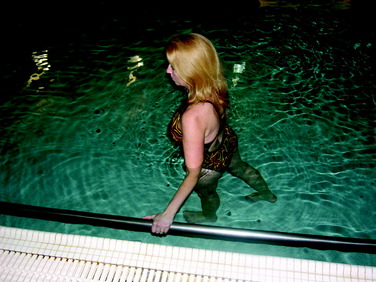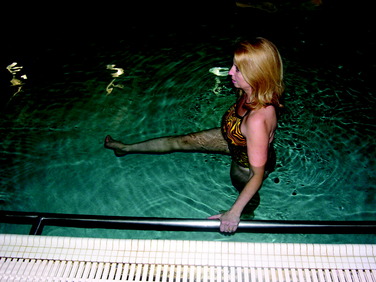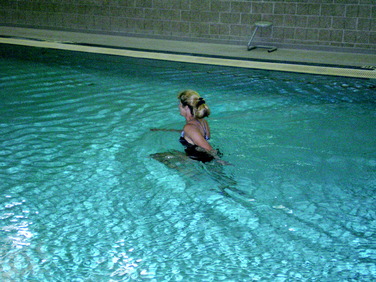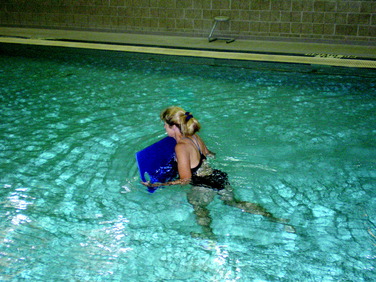Chapter 38 Aquatic Therapy for the Arthritic Knee
INTRODUCTION
Water has been used for healing, spiritual, and religious purposes since at least 2400 bc.15 Water was used by the people of Asia to combat fevers as early as 1500 BC. Hippocrates (460–375 BC) used water for relief of muscle spasms and joint pain.23 For many years, water exercise was dismissed as a medical intervention and considered to be purely recreational. The advent of spas in Europe and around the world moved water-based interventions into the leisure and recreation category, making reimbursement for water-based medical interventions difficult.
Despite a history spanning over 4000 years, a resurgence of aquatics as an intervention has occurred in the past quarter century. The Aquatic Section of the American Physical Therapy Association was organized as recently as 1992. Throughout this history, many different terms have been used to describe rehabilitation that takes place in the water. Some of these terms include hydrotherapy, aquatic therapy, spa therapy, water therapy, water gymnastics, balneotherapy, and pool therapy. Currently, the term balneotherapy is still distinguished from other forms of hydrotherapy. Balneotherapy refers to the use of hot-water or thermal treatments to decrease pain and stiffness and promote muscle relaxation. Balneotherapy often uses minerals, salts, or sulfur treatments, mud packs, and water jets to achieve these goals. Hydrotherapy is a general term covering any type of water intervention, which might include balneotherapy or exercise. For the purposes of this chapter, the focus remains on the use of exercise in water for the treatment of knee arthritis. For further information on balneotherapy, the reader is referred to Verhagen and coworkers.36
SCIENTIFIC BASIS
Buoyancy
Buoyancy is the upward thrust experienced during immersion that is in direct opposition to gravity. Buoyancy is used to unload the lower extremity from the effects of gravity, making it a useful tool for those with knee arthritis. Archimedes’ principle states that an immersed body at rest experiences an upward thrust equal to the weight of the same fluid volume it displaces.6
Buoyancy is related to a person’s specific gravity (SG), which varies with body composition. Any object with an SG less than 1.0 g/cm2 will float, whereas any object with an SG greater than 1.0 g/cm2 will sink. This property forms the basis of underwater weighing to determine body composition. Because lean body mass is heavier than fat mass, those with a high lean body mass tend to sink whereas those with a greater fat mass float. This fact makes it difficult to know precisely how much weight-bearing any given individual is achieving at a given water depth. Harrison and Bulstrode20 performed studies on the percentage of weight-bearing during static standing in various water depths ranging from the hips to the neck. The authors found considerable variability in the amount of weight-bearing with immersion at various depths. This variation might have been partly due to using a fixed-depth pool and only nine subjects. However, the disparity may also be the result of differences in body composition and body fat distribution among individual study subjects, suggesting that a weight-bearing prescription is difficult in this medium. A follow-up study by Harrison and associates21 showed that, compared with static standing, fast walking increased weight-bearing forces up to 76%. Understanding Archimedes’ principle highlights the difficulties in assigning a specific percentage of weight-bearing at any given depth: the weight on the limb will vary with body composition and speed of movement.
The moment of buoyancy is also important in exercise prescription. As with moments of gravity on land, the moment of buoyancy increases with increasing lever arm length and nearer the parallel. If the movement is in an upward direction, the same direction as the force of buoyancy, the activity is considered to be buoyancy assisted. If the movement is toward the pool bottom in opposition to buoyancy, it is considered to be buoyancy resisted. Movements parallel to the bottom that are neither assisted nor resisted by buoyancy are considered buoyancy-supported exercises. For example, in a standing position, a straight leg lift forward would be assisted by buoyancy, whereas the return motion back to the neutral position would be buoyancy resisted. In a supine position, hip abduction and adduction would be buoyancy-supported activities. An important application of this information is used in strengthening hip extensor muscles. In a standing position, the motion of hip extension from neutral to 15° extension (the normal range of hip extension) occurs through such a small range of motion (ROM), with a short moment arm, and is buoyancy assisted, making the exercise little more than a gluteal isometric exercise (Fig. 38-1). However, the motion from 90° hip flexion returning to neutral is also hip extension, but is now moving through a larger range with a longer moment arm against the upward force of buoyancy, making this an effective hip extensor muscle–strengthening exercise (Fig. 38-2).
Hydrostatic Pressure
Pascal’s law states that a fluid exerts pressure equally on an object at a given depth.6 Hydrostatic pressure increases with a greater depth of immersion owing to the weight of the volume of fluid overhead. The increased hydrostatic pressure close to the bottom of the pool assists venous return to the heart and prevents fluid accumulation in the lower extremities. This is useful for patients with knee or ankle arthritis, who tend to experience swelling with exercise. The increased venous return to the heart also affects the cardiorespiratory system. The hydrostatic pressure when the body is immersed to the neck produces an increase in heart volume, intrapulmonary blood volume, right atrial pressure, left ventricular end-diastolic volume, stroke volume, and cardiac output.2,9 Heart rate is unchanged or decreased compared with similar land-based activities.2 Peripheral circulation and vital capacity are decreased.9 This cardiopulmonary response is significant for patients with cardiorespiratory conditions and for those who are trying to achieve training heart rates in deep-water exercise.19 These changes have been noted in individuals both with and without cardiac disease.10,11 Aerobic exercise in neck-deep water will result in heart rates that are approximately 17 to 20 beats/min lower than comparable land-based exercise.3,18,31,34
Viscosity and Hydrodynamics
The viscosity of a fluid is its resistance to adjacent fluid layers sliding freely by one another.6 Viscosity causes a resistance to flow when a body is moving through the water. As such, viscosity is clinically insignificant when a body is stationary. The viscous quality of water allows it to be used effectively for resistance because of its hydrodynamic properties, or fluid mechanics. The key hydrodynamic properties are turbulence and drag.33 Turbulent flow occurs when the speed of movement of an object (or person or body part) reaches a critical velocity or when the flow of water encounters an object (or person or body part).4 In turbulent flow, resistance is proportional to the velocity squared, and increasing the speed of movement significantly increases the resistance.27 Eddies are formed in the wake behind the moving body, creating drag that is greater in the unstreamlined object than in a streamlined object (Figs. 38-3 and 38-4).
Several areas of research provide evidence for these variables. A study by Law and Smidt25 examined the impact of surface area and velocity on force production. Hydrotone (Hydro-Tone Fitness Systems, Inc., Huntington Beach, CA) bells were used at different speeds and angles to assess the impact on force production. Results showed a 50% increase in force production at fast speeds. Force also increased at fast speeds when the bells were oriented at 45° compared with 0°. Orientation had no impact on force production when performed at slow speeds. Therefore, both speed and surface area influence force production when using viscosity. Another study using the Hydrotone boots showed increased drag compared with a barefoot condition.28
A third study examined electromyographic (EMG) data from the shoulder musculature during arm elevation at three different speeds (30°/sec, 45°/sec, and 90°/sec) on land and in the water.24 The percentage of maximum voluntary contraction of the deltoid and rotator cuff musculature was consistently higher on land at the slowest speeds, but higher in the water at 90°/sec, highlighting the positive relationship among viscosity, speed, and force generation.
Poyhonen and colleagues27–29 performed several research studies on the hydrodynamics of knee flexion and extension exercises in water and on land in barefoot and increased surface area conditions. The authors found that increasing the surface area of the lower leg significantly increased the level of water resistance. They also found that the EMG activity of the knee flexors and extensors was similar between barefoot and increased surface area conditions despite the increased drag due to the Hydrotone Boot.
Research in the cardiopulmonary effects of speed on measures of exertion also supports the positive relationship between speed and work in the water. Whitley and Schoene38 examined walking on land and in the water at four different speeds. Heart rates were significantly higher after water-walking versus treadmill-walking at all four speeds. In addition, heart rates rose significantly with each increasing speed in water-walking, suggesting increasing cardiopulmonary workloads at increasing speeds. Cassady and Nielsen8 measured oxygen consumption during calisthenic arm and leg exercises at three different speeds on land and in the water. They also found increasing heart rate with increasing speed of exercise in the water. The higher metabolic cost of exercises at a faster speed supports the theory of increased work at faster speeds in the water.
CLINICAL RESEARCH
New clinical research has shown the effectiveness of aquatic rehabilitation for patients with musculoskeletal problems, particularly those with knee arthritis. A study examining outcomes following a water-based program for patients with lower limb osteoarthritis found that group-based water exercise classes over 1 year produced significant reductions in pain and improvements in function.12 A randomized, controlled trial (RCT) compared the effects of a water-based resistance program with a land-based program on function and strength in patients with osteoarthritis of the hip or knee.16 The authors found improvements in strength and function in both the land- and the water-based groups as compared with the control group. Compliance rates were 84% for water therapy and 75% for land therapy. In a similar study, Wyatt and coworkers39 examined changes in function following a land-based or an aquatic exercise program in patients with knee osteoarthritis. Both groups showed significant improvements in measures of ROM, thigh girth, pain scales, and 1-mile walk test. However, the aquatic group had significantly lower pain levels than the land group. Silva and associates32 followed 64 patients with knee osteoarthritis randomly assigned to a land-based or a hydrotherapy program. Both land and water exercises reduced knee pain and increased function, but the hydrotherapy group had significantly lower knee pain scores before and after the 50-foot walk test. The results reinforce the notion that patients can improve strength and function effectively in either a land or an aquatic environment. The key is the ability to provide a comprehensive program, whether on land, in the water, or some combination of both.
Recently, Hinman and colleagues22 performed an RCT randomly assigning 71 participants with hip or knee osteoarthritis to 6 weeks of aquatic physical therapy or no physical therapy. Those in the aquatic physical therapy program had less pain and joint stiffness and greater physical function, quality of life, and hip muscle strength than the control group. Nearly 75% of participants reported improvements in pain and function compared with 17% in the control group. More importantly, 84% of participants continued the aquatic program independently at the conclusion of the study.
Whereas the previous study compared aquatic physical therapy with no physical therapy, Fransen and coworkers17 compared hydrotherapy with Tai Chi or a control group in an RCT of 152 patients with hip or knee osteoarthritis. Results showed that both hydrotherapy and Tai Chi participants improved in the pain and physical function subscales of the Western Ontario and McMaster Osteoarthritis Index (WOMAC), but only the hydrotherapy group achieved significant improvements in the physical performance measures of the Short Form-12-item questionnaire (SF-12). In addition, compliance with the hydrotherapy classes was higher than that with Tai Chi.
An RCT of the effects of a water-based program on balance, fear of falling, and quality of life was performed in community-dwelling older women with osteopenia or osteoporosis.14 The intervention group received a 10-week water-based and self-management program. The intervention group showed significant improvement over the control group in balance and quality of life, but not in fear of falling.
Although structured aquatic physical therapy for patients with knee arthritis is relatively new, there is evidence supporting the clinical effectiveness and cost-effectiveness of this intervention in this population. A Cochrane Review examining the effectiveness of aquatic physical therapy for the treatment of hip and knee osteoarthritis is ongoing.5













